JLG G10-43A Operator Manual
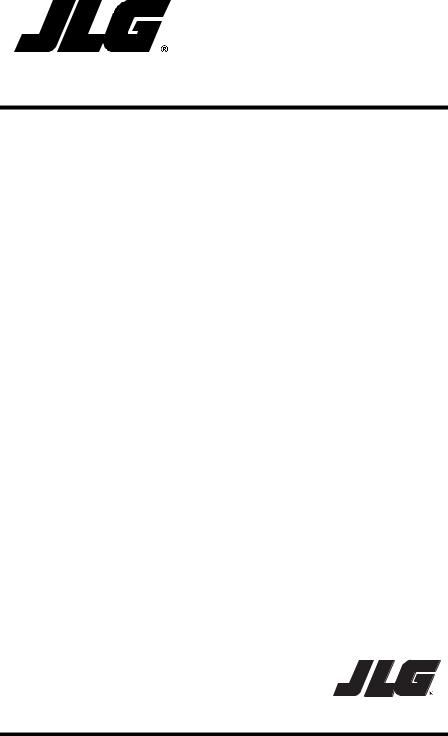
Operation & Safety
Manual
Original Instructions Keep this manual with machine at all times.
Models
G10-55A
&
G12-55A AccuPlace
3128447
Revised
January 5, 2010
An Oshkosh Corporation Company
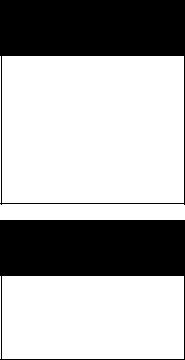
CALIFORNIA PROPOSITION 65
BATTERY WARNING
Battery posts, terminals and related accessories contain lead and lead compounds, chemical known to the State of California
to cause cancer and reproductive harm.
WASH HANDS
AFTER HANDLING!
CALIFORNIA PROPOSITION 65
EXHAUST WARNING
Diesel Engine exhaust and some of its constituents are known to the State of California to cause cancer, birth defects and other reproductive harm.

Revision Log
REVISION LOG
December 5, 2008 - A - Original Issue of Manual
December 19, 2008 - B - Revised page 3-15.
January 5, 2010 - C - Revised covers and pages b, 1-5, 1-6, 2-1, 2-6, 4-5, 4-8, 5-2, 5-14, 5-15, 5-16, 5-18, 5-20, 5-22, 5-24 thru 5-28, 5-30, 5-32, 7-3, 7-5, 7-16, 7-19, 7-21, 9-2 & 9-3.
3128447 |
a |
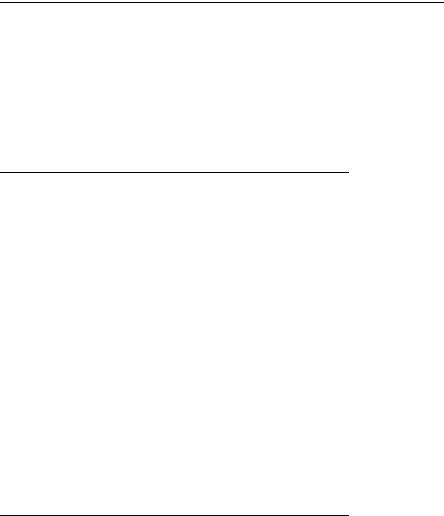
Read This First
This manual is a very important tool! Keep it with the machine at all times.
The purpose of this manual is to provide owners, users, operators, lessors, and lessees with the precautions and operating procedures essential for the safe and proper machine operation for its intended purpose.
Due to continuous product improvements, JLG Industries, Inc. reserves the right to make specification changes without prior notification. Contact JLG Industries, Inc. for updated information.
Operator Qualifications
The operator of the machine must not operate the machine until this manual has been read, training is accomplished and operation of the machine has been completed under the supervision of an experienced and qualified operator. Operation within the U.S.A. requires training per OSHA 1910.178.
Operators of this equipment must possess a valid, applicable driver’s license, be in good physical and mental condition, have normal reflexes and reaction time, good vision and depth perception and normal hearing. Operator must not be using medication which could impair abilities nor be under the influence of alcohol or any other intoxicant during the work shift.
In addition, the operator must read, understand and comply with instructions contained in the following material furnished with the telehandler:
•This Operation & Safety Manual
•Telehandler Safety Manual (ANSI only)
•All instructional decals and plates
•Any optional equipment instructions furnished
The operator must also read, understand and comply with all applicable Employer, Industry and Governmental rules, standards and regulations.
Modifications
Any modification to this machine must be approved by JLG.
b |
3128447 |

Read This First
This product must comply with all safety related bulletins. Contact JLG Industries, Inc. or the local authorized JLG representative for information regarding safetyrelated bulletins which may have been issued for this product.
JLG Industries, Inc. sends safety related bulletins to the owner of record of this machine. Contact JLG Industries, Inc. to ensure that the current owner records are updated and accurate.
JLG Industries, Inc. must be notified immediately in all instances where JLG products have been involved in an accident involving bodily injury or death of personnel or when damage has occurred to personal property or the JLG product.
FOR:
•Accident Reporting and Product Safety Publications
•Current Owner Updates
•Questions Regarding Product Applications and Safety
•Standards and Regulations Compliance Information
•Questions Regarding Product Modifications
CONTACT:
Product Safety and Reliability Department
JLG Industries, Inc.
13224 Fountainhead Plaza
Hagerstown, MD 21742
USA
or Your Local JLG Office (Addresses on back cover)
In USA:
Toll Free: 1-877-JLG-SAFE (1-877-554-7233)
Outside USA:
Phone: +1-717-485-6591
E-mail: ProductSafety@JLG.com
3128447 |
c |

Read This First |
|
Other Publications Available |
|
Service Manual.......................................................................................... |
31200452 |
Parts Manual ............................................................................................. |
31200454 |
Note: The following standards may be referenced in this manual: ANSI is compliant to ANSI/ITSDF B56.6
AUS is compliant to AS 1418.19 CE is compliant to EN1459
Refer to the machine Serial Number Plate to identify the applicable compliance standard.
d |
3128447 |

|
Table of Contents |
|
|
TABLE OF CONTENTS |
|
Revision Log |
|
|
Read This First |
|
|
|
Operator Qualifications ...................................................... |
b |
|
Modifications ...................................................................... |
b |
|
Other Publications Available .............................................. |
d |
Table of Contents |
|
|
Section 1 - General Safety Practices |
|
|
1.1 |
Hazard Classification system............................................... |
1-1 |
|
Safety Alert System and Safety Signal Words................ |
1-1 |
1.2 |
General Precautions ............................................................ |
1-1 |
1.3 |
Operation Safety.................................................................. |
1-2 |
|
Electrical Hazards ........................................................... |
1-2 |
|
Tip Over Hazard.............................................................. |
1-3 |
|
Travel Hazard ................................................................. |
1-6 |
|
Load Falling Hazard........................................................ |
1-7 |
|
Lifting Personnel ............................................................. |
1-8 |
|
Driving Hazards On Slopes............................................. |
1-9 |
|
Pinch Points and Crush Hazards .................................. |
1-10 |
|
Fall Hazard.................................................................... |
1-12 |
|
Chemical Hazards......................................................... |
1-13 |
Section 2 - Pre-Operation and Inspection |
|
|
2.1 |
Pre-Operation Check and Inspection................................... |
2-1 |
2.2 |
Safety Decals....................................................................... |
2-3 |
2.3 |
Walk-Around Inspection....................................................... |
2-6 |
2.4 |
Warm-Up and Operational Checks...................................... |
2-8 |
|
Warm-Up Check ............................................................. |
2-8 |
|
Operational Check .......................................................... |
2-8 |
2.5 |
Operator Cab ....................................................................... |
2-9 |
2.6 |
Windows ............................................................................ |
2-10 |
|
Cab Door Window (if equipped).................................... |
2-10 |
Section 3 - Controls and Indicators |
|
|
3.1 |
General ................................................................................ |
3-1 |
3.2 |
Controls ............................................................................... |
3-2 |
|
Instrument Panel............................................................. |
3-4 |
|
Display ............................................................................ |
3-5 |
|
Ignition ............................................................................ |
3-6 |
|
Park Brake ...................................................................... |
3-7 |
|
Parking Procedure .......................................................... |
3-7 |
|
Transmission Control Lever ............................................ |
3-8 |
3128447 |
i |

Table of Contents
|
Boom Joystick .............................................................. |
3-10 |
|
Frame Level Joystick.................................................... |
3-12 |
|
Auxiliary Hydraulic Joystick .......................................... |
3-13 |
|
Outrigger Joysticks ....................................................... |
3-14 |
|
Right Panel ................................................................... |
3-15 |
|
Accessory Control Lever (if equipped) ......................... |
3-16 |
|
Heater and Air Conditioning Controls (if equipped) ...... |
3-17 |
3.3 |
Steer Modes ...................................................................... |
3-18 |
|
Steer Mode Change ..................................................... |
3-18 |
3.4 |
Operator Seat.................................................................... |
3-19 |
|
Adjustments.................................................................. |
3-19 |
|
Seat Belt ....................................................................... |
3-20 |
3.5 |
Boom Angle and Extension Indicators .............................. |
3-21 |
Section 4 - Operation
4.1 Engine ................................................................................. |
4-1 |
Starting the Engine ......................................................... |
4-1 |
Battery Boosted Starting................................................. |
4-2 |
Normal Engine Operation ............................................... |
4-3 |
Shut-Down Procedure .................................................... |
4-3 |
4.2 Operating with a Non-Suspended Load .............................. |
4-4 |
Lift Load Safely............................................................... |
4-4 |
Picking Up a Load .......................................................... |
4-4 |
Transporting a Load ....................................................... |
4-5 |
Leveling Procedure......................................................... |
4-5 |
Placing a Load................................................................ |
4-6 |
Disengaging a Load........................................................ |
4-6 |
4.3 Operating with a Suspended Load ...................................... |
4-7 |
Lift Load Safely............................................................... |
4-7 |
Picking Up a Suspended Load ....................................... |
4-7 |
Transporting a Suspended Load .................................... |
4-8 |
Leveling Procedure......................................................... |
4-8 |
Placing a Suspended Load............................................. |
4-9 |
Disengaging a Suspended Load .................................... |
4-9 |
4.4 Loading and Securing for Transport.................................. |
4-10 |
Tiedown ........................................................................ |
4-10 |
Lifting ............................................................................ |
4-11 |
Section 5 - Attachments
5.1 |
Approved Attachments ........................................................ |
5-1 |
5.2 |
Unapproved Attachments.................................................... |
5-1 |
5.3 |
JLG Supplied Attachments.................................................. |
5-2 |
5.4 |
Telehandler/Attachment/Fork Capacity ............................... |
5-3 |
ii |
3128447 |

|
Table of Contents |
|
5.5 |
Use of the Capacity Chart.................................................... |
5-4 |
|
Capacity Indicator Locations........................................... |
5-4 |
|
Sample Capacity Chart ................................................... |
5-6 |
|
Example .......................................................................... |
5-8 |
5.6 |
Attachment Installation ...................................................... |
5-10 |
5.7 |
Hydraulic Operated Attachment......................................... |
5-12 |
5.8 |
Adjusting/Moving Forks...................................................... |
5-13 |
5.9 |
Attachment Operation........................................................ |
5-14 |
|
Carriage w/Forks........................................................... |
5-15 |
|
Side Tilt Carriage .......................................................... |
5-16 |
|
Swing Carriage ............................................................. |
5-18 |
|
Mast Carriage ............................................................... |
5-20 |
|
Mast Carriage w/Side Tilt.............................................. |
5-22 |
|
Fork Mounted Hook ...................................................... |
5-24 |
|
Truss Boom................................................................... |
5-26 |
|
Bucket ........................................................................... |
5-28 |
|
Grapple Bucket ............................................................. |
5-30 |
|
Personnel Work Platform - Fork Mounted..................... |
5-32 |
Section 6 - Emergency Procedures |
|
|
6.1 |
Towing a Disabled Product.................................................. |
6-1 |
|
Moving Short Distances .................................................. |
6-1 |
|
Moving Longer Distances ............................................... |
6-1 |
6.2 |
Emergency Lowering of Boom............................................. |
6-2 |
6.3 |
Emergency Exit from Enclosed Cab .................................... |
6-2 |
Section 7 - Lubrication and Maintenance |
|
|
7.1 |
Introduction .......................................................................... |
7-1 |
|
Clothing and Safety Gear................................................ |
7-1 |
7.2 |
General Maintenance Instructions ....................................... |
7-2 |
7.3 |
Service and Maintenance Schedule .................................... |
7-3 |
|
10 & 1st 100 Hour Maintenance Schedule ..................... |
7-3 |
|
50, 250 & 500 Hour Maintenance Schedule ................... |
7-4 |
|
1000 & 1500 Hour Maintenance Schedule ..................... |
7-5 |
7.4 |
Lubrication Schedules ......................................................... |
7-6 |
|
50 Hour Lubrication Schedule......................................... |
7-6 |
|
250 Hour Lubrication Schedule....................................... |
7-7 |
7.5 |
Operator Maintenance Instructions...................................... |
7-8 |
|
Fuel System .................................................................... |
7-8 |
|
Air Intake System.......................................................... |
7-10 |
|
Engine Oil ..................................................................... |
7-12 |
|
Hydraulic Oil.................................................................. |
7-13 |
|
Tires .............................................................................. |
7-14 |
3128447 |
iii |

Table of Contents
Transmission Oil........................................................... |
7-17 |
Hydraulic Return Filter.................................................. |
7-18 |
Engine Cooling System ................................................ |
7-19 |
Battery .......................................................................... |
7-20 |
Windshield Washer System (if equipped)..................... |
7-21 |
Section 8 - Additional Checks |
|
Section 9 - Specifications |
|
9.1 Product Specifications......................................................... |
9-1 |
Capacities....................................................................... |
9-1 |
Tires................................................................................ |
9-2 |
Performance ................................................................... |
9-3 |
Dimensions..................................................................... |
9-4 |
Index
Inspection, Maintenance and Repair Log
iv |
3128447 |
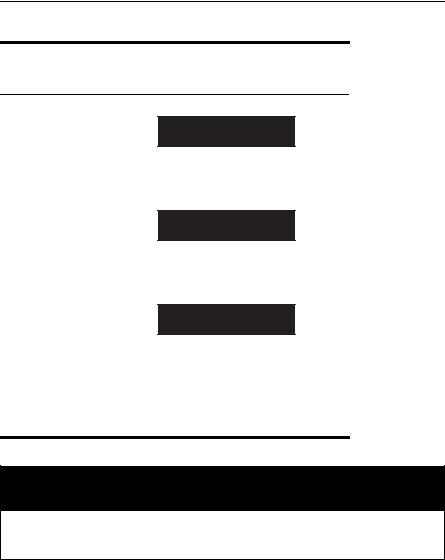
Section 1 - General Safety Practices
SECTION 1 - GENERAL SAFETY PRACTICES
1.1 HAZARD CLASSIFICATION SYSTEM
Safety Alert System and Safety Signal Words

 DANGER OW0010
DANGER OW0010
DANGER indicates an imminently hazardous situation which, if not avoided, will result in death or serious injury.

 WARNING OW0021
WARNING OW0021
WARNING indicates a potentially hazardous situation which, if not avoided, could result in death or serious injury.

 CAUTION OW0031
CAUTION OW0031
CAUTION indicates a potentiality hazardous situation which, if not avoided, may result in minor or moderate injury.
1.2GENERAL PRECAUTIONS
 WARNING
WARNING
Before operation, read & understand this manual. Failure to comply with the safety precautions listed in this manual could result in machine damage, property damage, personal injury or death.
3128447 |
1-1 |
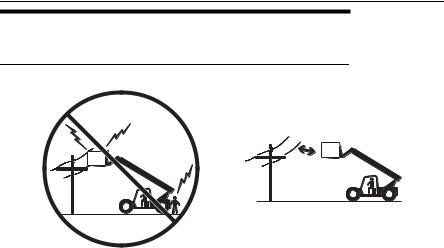
Section 1 - General Safety Practices
1.3 OPERATION SAFETY
Electrical Hazards
10 FT (3 M)
OW0040
•This machine is not insulated and does not provide protection from contact or being near electrical current.
•NEVER operate the telehandler in an area where overhead power lines, overhead or underground cables, or other power sources may exist without ensuring the appropriate power or utility company de-energizes the lines.
•Always check for power lines before raising the boom.
•Follow employer, local and governmental regulations for clearance from powerlines.
1-2 |
3128447 |
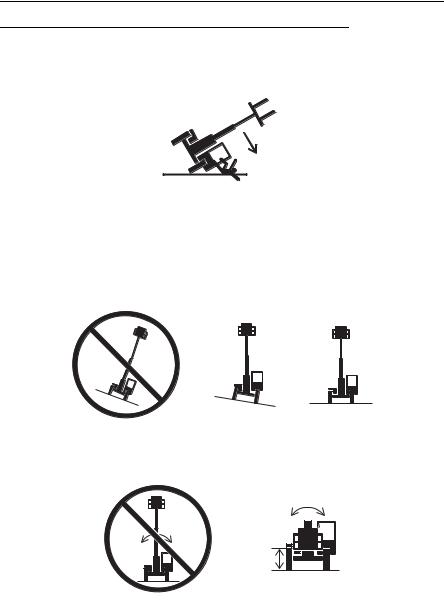
Section 1 - General Safety Practices
Tip Over Hazard
General
• For additional load requirements, refer to the appropriate capacity chart.
OW0050
•Never use an attachment without the appropriate JLG approved capacity chart installed on the telehandler.
•Understand how to properly use the capacity charts located in cab.
•DO NOT exceed rated lift capacity.
•Be sure that the ground conditions are able to support the machine.
OW0080
•DO NOT raise boom unless frame is level (0 degrees), unless otherwise noted on capacity chart.
4 FT
(1,2 M)
OW0100
•DO NOT level machine with boom/attachment above 4 ft (1,2 m).
(AUS - DO NOT level machine with load more than 11.8 in (300 mm) above ground surface.)
3128447 |
1-3 |
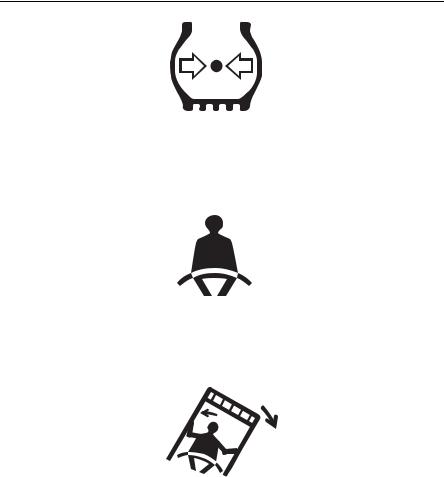
Section 1 - General Safety Practices
OH2291
•MAINTAIN proper tire pressure at all times. If proper tire pressures are not maintained, this machine could tip over.
•Refer to manufacturer’s specifications for proper fill ratio and pressure requirements for tires equipped with ballast.
OH20911
•Always wear the seat belt.
•Keep head, arms, hands, legs and all other body parts inside operator’s cab at all times.
OH2221
If the telehandler starts to tip over:
•DO NOT JUMP
•BRACE YOURSELF and STAY WITH THE MACHINE
•KEEP YOUR SEAT BELT FASTENED
•HOLD ON FIRMLY
•LEAN AWAY FROM THE POINT OF IMPACT
Trying to escape from a tipping machine could result in death or serious injury.
1-4 |
3128447 |

Section 1 - General Safety Practices
Non-Suspended Load
OW0060
• DO NOT drive with boom raised.
Suspended Load
OW0150
•Tether suspended loads to restrict movement.
•Weight of all rigging (slings, etc.) must be included as part of load.
•Beware of wind. Wind can cause a suspended load to swing and cause dangerous side loads - even with tag lines.
•DO NOT attempt to use telehandler frame-leveling to compensate for load swing.
•Keep heavy part of load closest to attachment.
•Never drag the load; lift vertically. When driving with a suspended load:
•Start, travel, turn and stop slowly to prevent load from swinging.
•DO NOT extend boom.
•DO NOT raise the load more than 11.8 in (300 mm) above ground surface or the boom more than 45°.
•DO NOT exceed walking speed.
3128447 |
1-5 |

Section 1 - General Safety Practices
Travel Hazard
2-Wheel Front Steer |
4-Wheel Circle Steer |
4-Wheel Crab Steer |
OAL2030
•Steering characteristics differ between steer modes. Identify the steer mode settings of the telehandler being operated.
•DO NOT change steer modes while traveling. Steer modes must be changed while telehandler is stationary.
•Visually verify proper wheel alignment after each steer mode change.
•Ensure that adequate clearance is provided for both rear tail swing and front fork swing.
•Look out for and avoid other personnel, machinery and vehicles in the area. Use a spotter if you DO NOT have a clear view.
•Before moving be sure of a clear path and sound horn.
•When driving, retract boom and keep boom/attachment as low as possible while maintaining visibility of mirrors and maximum visibility of path of travel.
•Always look in the direction of travel.
•Always check boom clearances carefully before driving underneath overhead obstructions. Position attachment/load to clear obstacles.
•When driving in high speed, use only front wheel steer (if steering modes are selectable).
1-6 |
3128447 |
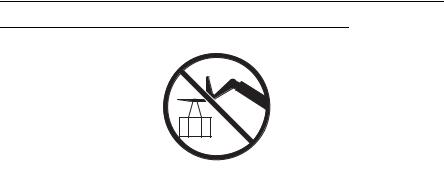
Section 1 - General Safety Practices
Load Falling Hazard
OW0130
•Never suspend load from forks or other parts of carriage.
•DO NOT burn or drill holes in fork(s).
•Forks must be centered under load and spaced apart as far as possible.
3128447 |
1-7 |
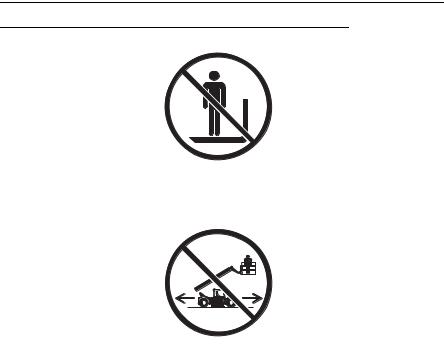
Section 1 - General Safety Practices
Lifting Personnel
•When lifting personnel, USE ONLY a JLG approved personnel work platform, with proper capacity chart displayed in the cab.
OW0190
• DO NOT drive machine from cab when personnel are in platform.
1-8 |
3128447 |

Section 1 - General Safety Practices
Driving Hazards On Slopes
OW0200
To maintain sufficient traction and braking capabilities, travel on slopes as follows:
•When unloaded, the rear of the machine is the “heavy end.” Drive with forks pointed downhill.
•When loaded, the front of the machine is the “heavy end.” Drive with the forks pointed uphill.
•For additional travel requirements, refer to the appropriate capacity chart.
•To avoid overspeeding the engine and drivetrain when driving down slopes, downshift to a lower gear and use the service brake as necessary to maintain a slow speed. DO NOT shift into neutral and coast downhill.
•Avoid excessively steep slopes or unstable surfaces. To avoid tip over DO NOT drive across excessively steep slopes under any circumstances.
•Avoid turning on a slope. Never engage “inching” or shift to “Neutral” when going downhill.
•DO NOT park on a slope.
3128447 |
1-9 |
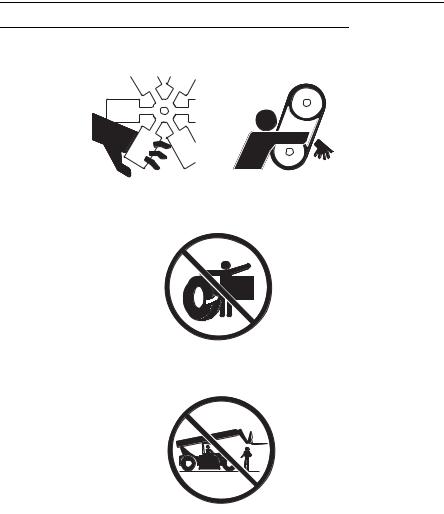
Section 1 - General Safety Practices
Pinch Points and Crush Hazards
Stay clear of pinch points and rotating parts on the telehandler.
OW0210
• Stay clear of moving parts while engine is running.
• Keep clear of steering tires and frame or other objects.
• Keep clear from under boom.
1-10 |
3128447 |
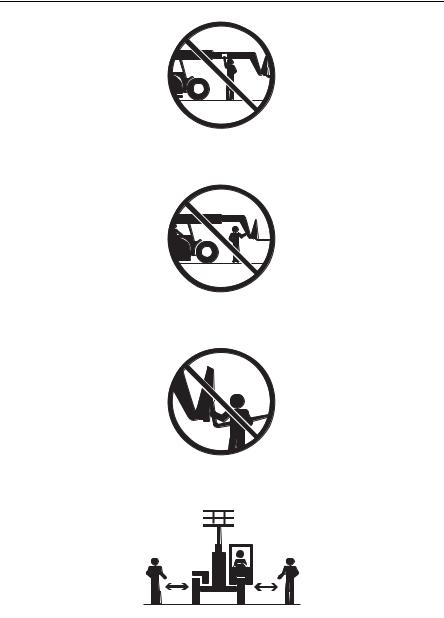
Section 1 - General Safety Practices
• Keep clear of boom holes.
• Keep arms and hands clear of attachment tilt cylinder.
• Keep hands and fingers clear of carriage and forks.
OW0960
• Keep others away while operating.
3128447 |
1-11 |

Section 1 - General Safety Practices
Fall Hazard
OW0280 |
•Enter using the proper hand holds and steps provided. Always maintain 3-point contact when mounting or dismounting. Never grab control levers or steering wheel when mounting or dismounting the machine.
•DO NOT get off the machine until the shutdown procedure on page 4-3 has been performed.
OW0290
•DO NOT carry riders. Riders could fall off machine causing death or serious injury.
1-12 |
3128447 |
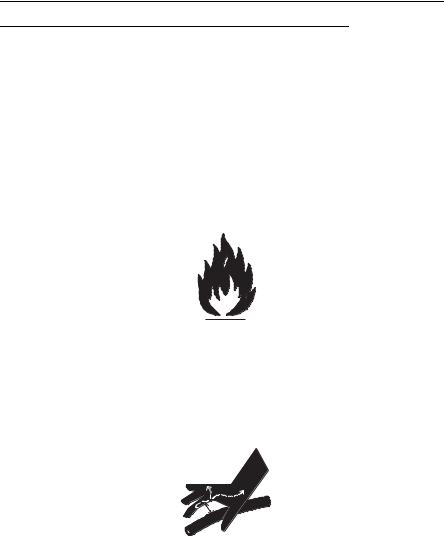
Section 1 - General Safety Practices
Chemical Hazards
Exhaust Fumes
•DO NOT operate machine in an enclosed area without proper ventilation.
•DO NOT operate the machine in hazardous environments unless approved for that purpose by JLG and site owner. Sparks from the electrical system and the engine exhaust can cause an explosion.
•If spark arrestors are required, ensure they are in place and in good working order.
Flammable Fuel
OW0300
•DO NOT fill the fuel tank or service the fuel system near an open flame, sparks or smoking materials. Engine fuel is flammable and can cause a fire and/or explosion.
Hydraulic Fluid
OW0950
•DO NOT attempt to repair or tighten any hydraulic hoses or fittings while the engine is running or when the hydraulic system is under pressure.
•Stop engine and relieve trapped pressure. Fluid in the hydraulic system is under enough pressure that it can penetrate the skin.
•DO NOT use your hand to check for leaks. Use a piece of cardboard or paper to search for leaks. Wear gloves to protect hands from spraying fluid.
3128447 |
1-13 |

Section 1 - General Safety Practices
This Page Intentionally Left Blank
1-14 |
3128447 |
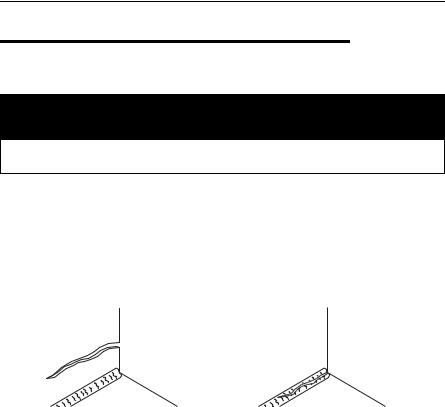
Section 2 - Pre-Operation and Inspection
SECTION 2 - PRE-OPERATION AND INSPECTION
2.1PRE-OPERATION CHECK AND INSPECTION
Note: Complete all required maintenance before operating unit.
 WARNING
WARNING
FALL HAZARD. Use extreme caution when checking items beyond your normal reach. Use an approved ladder.
The pre-operation check & inspection, performed at beginning of each work shift or at each change of operator, should include the following:
1.Cleanliness - Check all surfaces for leakage (oil, fuel or battery fluid) or foreign objects. Report any leakage to the proper maintenance personnel.
2.Structure - Inspect the machine structure for dents, damage, weld or parent metal cracks or other discrepancies.
OAH1000
PARENT METAL CRACK |
WELD CRACK |
3.Safety Decals - Ensure all safety decals are legible and in place. Clean or replace as required. See page 2-3 for details.
4.Operation and Safety Manuals - Operation & Safety Manual and AEM Safety Manual (ANSI only) are located in cab manual holder.
5.Walk-Around Inspection - See page 2-6 for details.
6.Fluid Levels - Check fluids, including fuel, hydraulic oil, engine oil, transmission fluid and coolant. When adding fluids, refer to Section 7 - Lubrication and Maintenance and Section 9 - Specifications to determine proper type and intervals. Before removing filler caps or fill plugs, wipe all dirt and grease away from the ports. If dirt enters these ports, it can severely reduce component life.
7.Attachments/Accessories - Ensure correct capacity charts are installed on the telehandler. If provided, reference the Operation & Safety Manual of each attachment or accessory installed for specific inspection, operation and maintenance instructions.
3128447 |
2-1 |
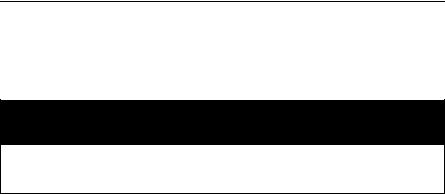
Section 2 - Pre-Operation and Inspection
8.Operational Check - Once the walk-around inspection is complete, perform a warm-up and operational check (see page 2-8) of all systems in an area free of overhead and ground level obstructions. See Section 3 - Controls and Indicators for more specific operating instructions.
 WARNING
WARNING
If telehandler does not operate properly, immediately bring machine to a stop, lower boom and attachment to ground and stop the engine. Determine cause and correct before continued use.
2-2 |
3128447 |
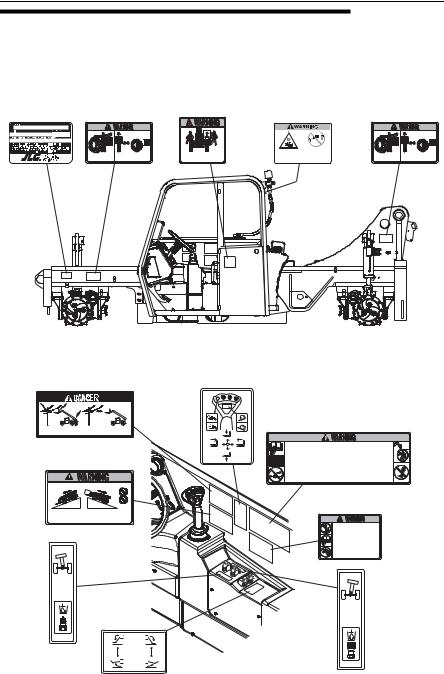
Section 2 - Pre-Operation and Inspection
2.2SAFETY DECALS
Ensure all DANGER, WARNING, CAUTION and instructional decals and proper capacity charts are legible and in place. Clean and replace as required.
1705881 |
91503108 |
91503109 |
1706300 |
91503108 |
|
M O V I N G PA RT S c o u l d c r u s h c a u s i n g d e a t h
o r s e r i o u s i n j u r y.
K e e p c l e a r o f w h e e l s a n d m o v i n g pa r ts w h i l e e n g i n e i s r u n n i n g .
9150-3108 REV -
N O R I D E R S . R i d e r s c o u l d FA L L O F F m a c h i n e c a u s i n g d e a t h o r s e r i o u s i n j u r y.
|
|
|
|
|
DO NOT use Ether or |
||
ENGINE EXPLOSION |
other high energy |
||
could result in death |
starting aids. |
||
or serious injury. |
Engine equipped with |
||
|
Pre-heating system. |
||
M O V I N G PA RT S c o u l d c r u s h c a u s i n g d e a t h
o r s e r i o u s i n j u r y.
K e e p c l e a r o f w h e e l s a n d m o v i n g pa r ts w h i l e e n g i n e i s r u n n i n g .
9150-3108 REV -
91503110 |
1707038 |
|
|
10 FT. |
|
|
(3 M) |
|
CONTACTING ELECTRIC POWER |
D o n o t p l a c e m a c h i n e o r l o a d |
|
L I N E S w i l l r e s u l t i n d e a t h |
w i t h i n 1 0 f e e t ( 3 m ) o f e l e c t r i c |
|
o r s e r i o u s i n j u r y. |
p o w e r l i n e s . |
9150-3110 REV - A |
|
|
|
91563246 |
1707038D |
|
GEAR |
|
4 |
|
3 |
|
2 |
D o w n - s h i f t t o a l o w e r g e a r w h e n d e s c e n d i n g . |
1 |
O v e r s p e e d i n g o f d r i v e t r a i n c o u l d r e s u l t i n |
|
e q u i p m e n t d a m a g e o r p e r s o n a l i n j u r y . |
9156-3246 REV A
1001100996 A
1001100996
1001100999 A
1001100999
91503098
For safe operation of machine, and to minimize risk of s e r i o u s i n j u r y, R E A D A N D O B S E RV E t h e f o l l o w i n g :
|
1. Only trained and authorized personnel may operate this |
6. Keep others away from machine when operating. Do not |
|
allow others to stand under boom or load. Always look in |
|
|
machine. |
direction of travel. |
|
2. Before operating, read and understand all capacity charts, |
|
|
operator manual and safety manuals. |
7. Use extreme care when handling long, high or wide loads. |
|
3. Operator must be seated with seat belt fastened. Assure all |
Do not handle unstable or loosely stacked loads. |
|
controls are in neutral before ignition switch is turned on. |
8. Forks must be centered under load, and spaced apart as far |
|
4. Do not travel with boom raised. When traveling, fully |
as possible. |
|
retract boom and place forks in carry position, which is |
9. Level machine before lifting any load above 4 feet (1.2m). |
|
approximately 4 feet (1.2 m) above ground. Tilt carriage |
|
|
back slightly to cradle load. Use extreme caution when |
|
|
turning. |
10. Improper use of machine could result in machine tipping |
|
|
over. If machine starts to tip over, do not leave operator's |
|
5. On inclines, travel with load up-grade. |
seat. Lean away from tip, and brace yourself. |
|
|
11. Keep mirror(s) clean and properly adjusted. Objects in |
|
|
mirror(s) are closer than they appear. |
91513208
When lifting personnel, USE ONLY a Gradall manufactured personnel work platform, with proper personnel work platform CAPACITY CHART DISPLAYED in cab.
READ AND UNDERSTAND personnel work platform Owner/Operator manual before lifting personnel.
DO NOT DRIVE machine from cab when personnel are on platform.
All personnel on platform must WEAR A FULL BODY HARNESS, with lanyard attached to a designated anchorage point.
When personnel are on platform, the OPERATOR MUST REMAIN
SEATED in cab with personnel in direct line of sight.
OPERATE CONTROLS CAUTIOUSLY and lightly when lifting or positioning personnel.
Failure to comply could result in death or serious injury.
1001100998 A
1001100998 OY1260
3128447 |
2-3 |
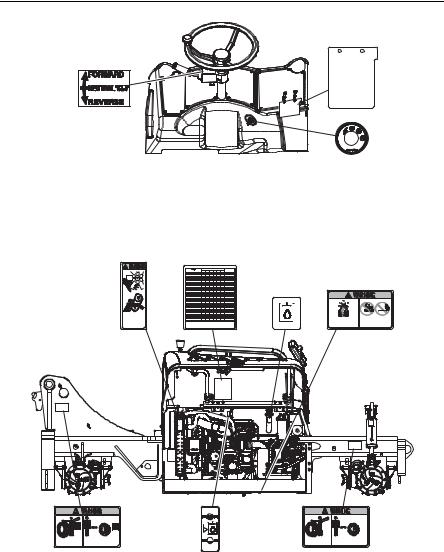
Section 2 - Pre-Operation and Inspection
CAPACITY CHARTS
91163028
91413061
VIEW OF CAB DASH
91503097 91563227
M O V I N G PA R T S c a n c u t o r e n t a n g l e . K e e p c l e a r w h i l e e n g i n e i s r u n n i n g .
9150-3097 REV. -
M O V I N G PA RT S c o u l d |
K e e p c l e a r o f w h e e l s a n d |
c r u s h c a u s i n g d e a t h |
m o v i n g pa r ts w h i l e e n g i n e |
o r s e r i o u s i n j u r y. |
i s r u n n i n g . |
9150-3108 REV - |
|
91503108 |
91563220 |
|
91503099
91513209
|
|
|
B a t t e r i e s p r o d u c e E X P L O S I V E |
K e e p s p a r k s , f l a m e s a n d l i g h t e d |
||
|
|
|
||||
|
|
|
G A S E S . E X P L O S I O N c o u l d |
m a t e r i a l s a w a y f r o m b a t t e r i e s . |
||
|
|
|
r e s u l t i n s e r i o u s i n j u r y. |
|
|
|
9151-3209 REV - |
|
9150-3099 REV - |
||||
|
|
|
|
|
|
|
|
|
|
|
|
|
|
|
|
|
|
|
|
|
|
|
|
|
|
|
|
M O V I N G PA RT S c o u l d |
K e e p c l e a r o f w h e e l s a n d |
c r u s h c a u s i n g d e a t h |
m o v i n g pa r ts w h i l e e n g i n e |
o r s e r i o u s i n j u r y. |
i s r u n n i n g . |
|
9150-3108 REV - |
91503108 OY1270
2-4 |
3128447 |
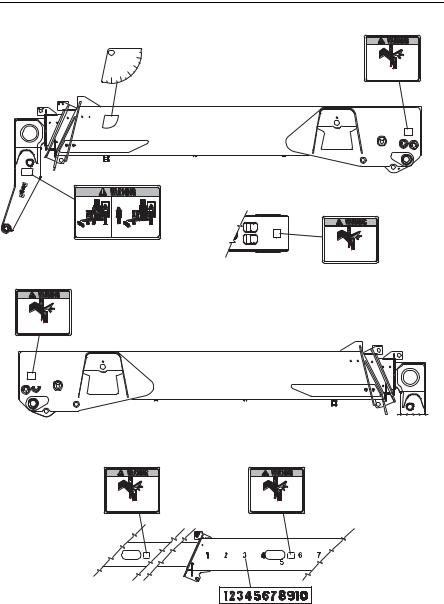
Section 2 - Pre-Operation and Inspection
4105262
|
|
0 |
|
|
|
8 |
|
|
|
0 |
0 |
|
|
7 |
|
|
|
6 |
|
|
0 |
4050 |
|
-10 |
2030 |
|
|
|
10 |
|
|
91513210
MOVING PARTS could cut or crush causing death or serious injury. Keep clear of
moving parts while engine is running.
9151-3210 REV -
A 
 A
A
91513210
MOVING PARTS could cut or crush causing death or serious injury. Keep clear of
moving parts while engine is running.
9151-3210 REV -
M O V I N G PA R T S c o u l d K e e p c l e a r o f s w i n g a t t a c h -
c r u s h c a u s i n g d e a t h |
m e n t s a n d m o v i n g p a r t s w h i l e |
|
o r s e r i o u s i n j u r y . |
e n g i n e i s r u n n i n g . |
9156-3157 REV C |
91563157
91513210
MOVING PARTS could cut or crush causing death or serious injury. Keep clear of
moving parts while engine is running.
9151-3210 REV -
VIEW A-A
91513210
MOVING PARTS could cut or crush causing death or serious injury. Keep clear of
moving parts while engine is running.
9151-3210 REV -
91553072
91513210
MOVING PARTS could cut or crush causing death or serious injury. Keep clear of
moving parts while engine is running.
9151-3210 REV -
OW0352
3128447 |
2-5 |

Section 2 - Pre-Operation and Inspection
2.3WALK-AROUND INSPECTION
|
1 |
18 |
|
|
|
2 |
|
17 |
3 |
|
16 |
|
|
|
|
|
15 |
4 |
|
|
5 |
5 |
|
|
14 |
6 |
|
|
13 |
7 |
|
8 |
12 |
|
|
9 |
|
10 11 OY1940
Begin your walk-around inspection at item 1, as noted below. Continue to your right (counterclockwise when viewed from top) checking each item in sequence.
INSPECTION NOTE: On all components, make sure there are no loose or missing parts, that they are securely fastened and no visible leaks or excessive wear exists in addition to any other criteria mentioned. Inspect all structural members including attachment for cracks, excessive corrosion and other damage.
1.Boom Sections and Lift, Tilt, Extend/Retract Cylinders -
•Check front, top, side and rear wear pads for presence of grease.
•Pivot pins secure; hydraulic hoses undamaged, not leaking.
2.Left Outrigger - Pins secure; hydraulic hoses and cylinder undamaged, not leaking.
3.Front Axle - Steer cylinders undamaged, not leaking; pivot pins secure; hydraulic hoses undamaged, not leaking.
2-6 |
3128447 |
